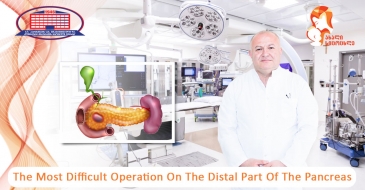A pancreaticoduodenal resection, described by medics as the most complicated surgical intervention in abdominal surgery, was carried out at the clinic “New Life.”
In this news, you will be informed about the following
Patient’s history
52 years old man was admitted to the clinic with acute pain and discomfort in the right abdomen. Mass in the head of the pancreas - cancer in the head of the pancreas, was detected with abdominal ultrasound and computed tomography with contrast.
The patient's health condition required a prompt surgical intervention. It’s worth mentioning that the patient had a co-morbidity – gout. That is why surgeons of our clinic had to manage two separate pathologies simultaneously.
Professional surgeons were able to overcome every obstacle! The operation was conducted: head of the pancreas, distal common bile duct, duodenum were removed. Concurrently, gout exacerbated and they treated this pathology on a post-operative basis.
Currently, the patient feels good, was already discharged from the clinic and returned to the usual rhythm of life.
What type of complexity is pancreaticoduodenal resection distinguished by? We’ve addressed this question to the head of the General and Laparoscopic Surgery Department of the clinic “New Life” Jaba Babaevi
What function does the pancreas have in the body?
The pancreas is a gland located in the upper abdominal cavity, behind the stomach. The pancreas plays an important role in digestive processes.
Pancreatic cancers are divided in two categories – benign and malignant and the latter is detected in advanced and exacerbated cases.
What is pancreaticoduodenal resection?
It’s quite complicated, severe surgical intervention and requires a surgeon to have vast experience. For removal of the mass, it's necessary to dissect many overlying blood vessels (for example, superior mesenteric artery, superior mesenteric vein, portal vein, splenic vein, aorta, inferior vena cava) and this is related to technical difficulties.
Due to the complex anatomical location of the pancreas, during the mentioned surgical intervention there is a high risk of bleeding compared to other operations.
Also, the following present potential complications:
- Suture insufficiency;
- Peritonitis;
- Sepsis;
- Fistula;
- Thromboembolism, etc.
Distant complications cannot be excluded as well, for example:
- Anastomotic stenoses
- Pancreatitis;
- Cholangitis.
A patient undergoes intense post-operative therapy, antibiotic therapy, anticoagulation therapy, a decrease of pancreatic fermentation, proton-pump inhibition to prevent these complications.
Currently, there’s no alternative treatment method but the operation.
Despite all these risk factors, the operation was a success!
What is gout?
The underlying cause of gout is the excess accumulation of uric acid in the body caused by renal function impairment.
Patients affected by this pathology experience foot deformity and biomechanical disorder. To visualize it, a big toe is curved abnormally.
Post-operative treatment was successfully conducted to restore foot biomechanics.
Wish you health!









